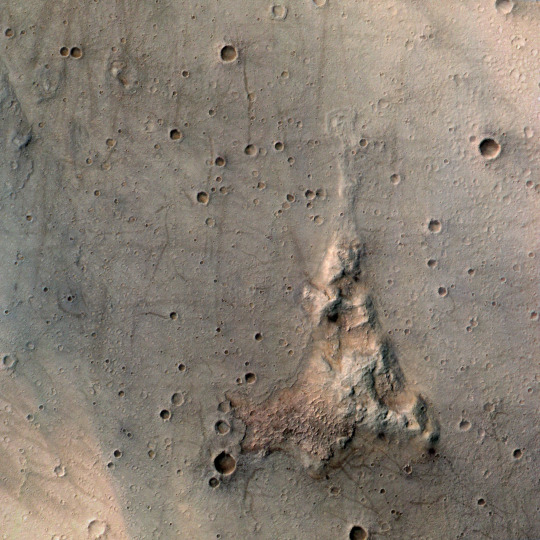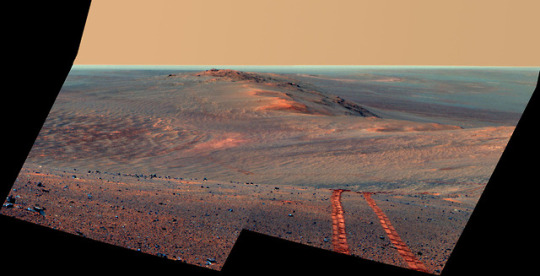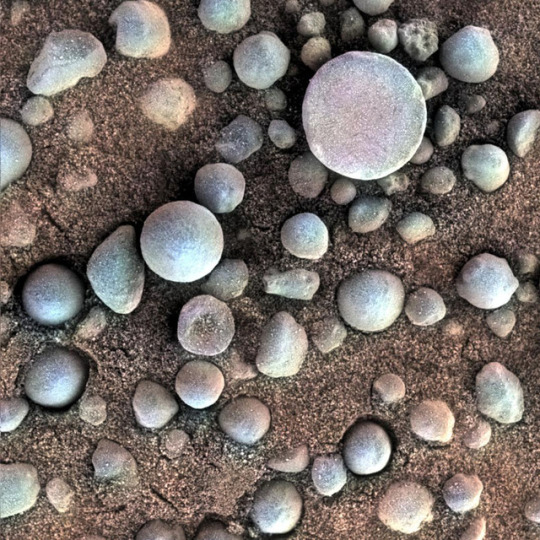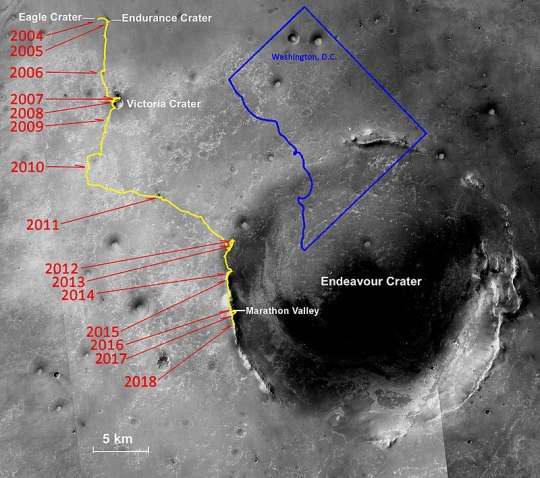#the nickname Gusev
Text
"Gusev" is probably the only unique thing attributed to Dmitriy. He lives his life through his imaginary twin, Fyodor, who carries all of his dreams and ambitions, and has all his friends, while Dmitriy carries on the legacy and wishes of a father that seemingly never cared for him. The only thing he has of his own is his nickname, Gusev, and nobody knows what it means or how it came to be.
#and with the way that he is - standoffish and central - nobody is going to care to ask#being a doctor. going to college. all a part of his fathers “game#until he becomes a bass player for his band the only thing he really has for himself *is* Fyodor. and until he reinvents himself:#the nickname Gusev#dmitriy izydorevich
0 notes
Photo

The Columbia Hills
This gorgeous processed image from the CTX camera on the Mars Reconnaissance Orbiter Spacecraft currently orbiting Mars shows the Columbia Hills, the final resting place of the Mars Rover Spirit. The overlain colors are from the CRISM instrument on the same spacecraft, and give an estimate of the composition of the rocks.
The rover landed on the nearly flat plains surrounding these hills to the West. It was targeted to a site known as Gusev crater, where a channel flows into the crater suggesting that it once might have hosted a lake. However, out on the plains, the rover discovered only basalt, remnant of more recent lava flows that once filled the crater.
In the distance, the rover could see a set of rocks sticking up above the lava-covered plains, named the Columbia Hills after the shuttle Columbia broke up upon reentry. Once the Rover arrived there, it began finding different rocks, including igneous rocks of different composition and eventually pyroclastic and hydrothermally altered rocks, verifying the presence of water as hot, water-rich fluids were required to produce the observed altered rock chemistry.
Eventually, the rover was trapped when a section of a set of altered rocks nicknamed “home plate” collapsed, leaving the rover buried in sediment just before the start of a martian winter.
It is unknown why the Columbia Hills stick up above the surroundings. They may have been a high ground that existed before the lava flows formed, or alternatively they could represent a portion of the earlier lake sediments that were uplifted on a fault of some sort, perhaps one related to settling of the crater itself. In this case, the observed altered rocks would have been sediments that interacted with high-temperature fluids and igneous rocks during later volcanism.
-JBB
Image credit: NASA / JPL / JHUAPL / MSSS / Justin Cowart
https://flic.kr/p/2jYE5Ca
#Spirit#mars#mer#mars exploration rover#gusev crater#basalt#geology#columbia hills#mro#mars reconnaissance orbiter#space#science#the universe#isuniverse#the real universe
39 notes
·
View notes
Text
Six Things to Know About NASA's Opportunity Mars Rover
NASA - Mars Exploration Rover B (MER -B) patch.
Feb. 13, 2019
Image above: This scene from the panoramic camera on NASA's Mars Exploration Rover Opportunity looks back toward part of the west rim of Endeavour Crater that the rover drove along, heading southward, during the summer of 2014. Image Credits: NASA/JPL-Caltech/Cornell/ASU.
After 15 years, the mission of NASA's Opportunity rover has come to an end, but its successes on Mars have earned it a spot in the robot hall of fame. Here's what you need to know about our intrepid Martian overachiever:
1. Opportunity was a twin.
Image above: This infographic highlights NASA’s twin robot geologists, the Mars Exploration Rovers (MER) Spirit and Opportunity. Image Credits: NASA/JPL-Caltech.
The Mars Exploration Rovers mission featured two identical, golf-cart-sized, solar-powered rovers: Spirit and Opportunity. Spirit landed at Gusev Crater on Jan. 4, 2004. Opportunity landed on the opposite side of Mars at Meridiani Planum on Jan. 24, 2004 PST (Jan. 25 EST). Both rovers were managed for NASA by NASA's Jet Propulsion Laboratory in Pasadena, California.
2. Opportunity and Spirit showed that Mars had the wet and warm conditions in its ancient past that were potentially hospitable to life.
Image above: The small spherules on the Martian surface in this close-up image are near Fram Crater, visited by NASA's Mars Exploration Rover Opportunity during April 2004. Image Credits: NASA/JPL-Caltech/Cornell/USGS.
Foremost among Spirit and Opportunity's many science discoveries: Mars was likely wetter and warmer in the past. These conditions could have served as a cradle for life on Mars at a time when life first emerged on Earth.
Opportunity contributed several key findings to this conclusion. It was the first rover to identify and characterize sedimentary rocks on a planet other than Earth. Opportunity's measurements showed these rocks formed in ancient ephemeral playas. Opportunity also discovered small spheres of hematite nicknamed "blueberries" that formed late from rising, acidic groundwater. Once Opportunity reached the rim of Endeavour crater, the rover found white veins of the mineral gypsum — a telltale sign of water that traveled through underground fractures. Opportunity also found more compelling signs of Mars' watery past in the rocks of Endeavour Crater: clay minerals that formed in neutral-pH (not too acidic, not too basic) water. Of all the places studied by Opportunity, the environment at Endeavour had the friendliest conditions for ancient microbial life.
3. Opportunity is an off-world record holder.
Image above: NASA's Mars Exploration Rover Opportunity used its panoramic camera to record this eastward horizon view on the 2,407th Martian day, or sol, of the rover's work on Mars (Oct. 31, 2010). Image Credits: NASA/JPL-Caltech/Cornell University.
Opportunity worked longer on the surface of Mars than any other robot — more than 14 years. This far exceeded the original 90-day mission planned for Opportunity and Spirit.
During Opportunity's time on Mars, it also drove a total of 28.06 miles (45.16 kilometers), clinching the record for longest drive on another world in 2014.
4. Opportunity was the little rover that could.
Image above: This scene from the panoramic camera (Pancam) of NASA's Mars Exploration Rover Opportunity catches "Pillinger Point," on the western rim of Endeavour Crater, in the foreground. It is presented in false color to make differences in surface materials more easily visible. Image Credits: NASA/JPL-Caltech/Cornell Univ./Arizona State Univ.
Opportunity didn't survive for over 14 years because its mission was easy. It encountered challenges that required its engineers to be resourceful. For instance, the rover's right-front wheel sometimes drew more current than the other wheels, so engineers often drove the rover backward to extend the right front wheel's life.
The terrain was treacherous. After the rover landed at Eagle Crater, its wheels slipped on the loose slopes when it first attempted to drive out of the crater. Rover planners had to come up with creative driving strategies to get out — something they did again at Endurance Crater, where slopes were as steep as 31 degrees. On April 26, 2005, Opportunity's wheels dug into a soft, wind-sculpted sand ripple and got stuck for several nail-biting weeks at "Purgatory Dune." But after extensive testing in a Mars-like sandbox at JPL, the team was able to carefully shimmy out of the Martian sand trap.
Opportunity encountered two mission-threatening dust storms that blocked sunlight from reaching its solar panels. It survived a dust storm in 2007 by minimizing activities and maintaining enough power in its batteries to recover when the skies cleared. Unfortunately, the 2018 dust storm blotted out even more sunlight and kept the skies above Opportunity dark about a month longer.
5. Opportunity and Spirit showed us the beauty of Mars.
Image above: From its perch high on a ridge, NASA's Mars Exploration Rover Opportunity recorded this image of a Martian dust devil twisting through the valley below. The view looks back at the rover's tracks leading up the north-facing slope of "Knudsen Ridge," which forms part of the southern edge of "Marathon Valley." Image Credits: NASA/JPL-Caltech.
Opportunity and Spirit were avid documentarians, giving us a human-scale view of what it was like to be on Mars. They returned over 342,000 raw images, which were promptly posted online for everyone's enjoyment. These two rovers also produced 31 stunning 360-degree color panoramas.
The most memorable images Opportunity took — including ripples of sand that resembled waves on water, patches of jumbled rock on a crater rim, whirling dust devils and its own tracks along a ridge — revealed the otherworldly beauty of Mars and the drama of exploration.
6. The story of Opportunity and Spirit is not over. Their lessons live on in current and future Mars missions.
Image above: In this navigation camera raw image, NASA's Opportunity Rover looks back over its own tracks on Aug. 4, 2010. NASA's Jet Propulsion Laboratory, a division of Caltech in Pasadena, manages the Mars Exploration Rover Project for NASA's Science Mission Directorate, Washington. Image Credits: NASA/JPL-Caltech.
The success of the Mars Exploration Rovers helped drive the growth of NASA's Mars program, building support for orbiters and new kinds of rovers. Spirit and Opportunity showed how mobile robots on Mars could communicate reliably with Earth (either directly or by employing orbiters around Mars as relays back to our home planet), use 3-D vision to navigate the Martian terrain and make autonomous science observations.
Curiosity and the upcoming Mars 2020 rovers build upon the lessons of Spirit and Opportunity. And scientists will continue to make new discoveries from the Mars Exploration Rovers data for years to come.
Mars Exploration Rover (MER). Image Credits: NASA/JPL-Caltech
Spirit and Opportunity have been a fertile training ground for the many hundreds of engineers and planetary scientists who have learned at their robotic knees. A number have gone on to lead other space missions. Many of those currently operating Opportunity are sharing their expertise part-time with other missions exploring our solar system. For most, working on Spirit and Opportunity has been transformative. You can read many of their stories here: https://www.jpl.nasa.gov/opportunity-memories/
For more highlights of the Mars Exploration Rover mission, visit: https://mars.nasa.gov/mer/highlights/
Images (mentioned), Text, Credits: NASA/Tony Greicius/JPL/Jia-Rui Cook.
Greetings, Orbiter.ch
Full article
342 notes
·
View notes
Photo







Six Things to Know About NASA's Opportunity Mars Rover After 15 years, the mission of NASA's Opportunity rover has come to an end, but its successes on Mars have earned it a spot in the robot hall of fame. Here's what you need to know about our intrepid Martian overachiever: 1. Opportunity was a twin. The Mars Exploration Rovers mission featured two identical, golf-cart-sized, solar-powered rovers: Spirit and Opportunity. Spirit landed at Gusev Crater on Jan. 4, 2004. Opportunity landed on the opposite side of Mars at Meridiani Planum on Jan. 24, 2004 PST (Jan. 25 EST). Both rovers were managed for NASA by NASA's Jet Propulsion Laboratory in Pasadena, California. 2. Opportunity and Spirit showed that Mars had the wet and warm conditions in its ancient past that were potentially hospitable to life. Foremost among Spirit and Opportunity's many science discoveries: Mars was likely wetter and warmer in the past. These conditions could have served as a cradle for life on Mars at a time when life first emerged on Earth. Opportunity contributed several key findings to this conclusion. It was the first rover to identify and characterize sedimentary rocks on a planet other than Earth. Opportunity's measurements showed these rocks formed in ancient ephemeral playas. Opportunity also discovered small spheres of hematite nicknamed "blueberries" that formed late from rising, acidic groundwater. Once Opportunity reached the rim of Endeavour crater, the rover found white veins of the mineral gypsum - a telltale sign of water that traveled through underground fractures. Opportunity also found more compelling signs of Mars' watery past in the rocks of Endeavour Crater: clay minerals that formed in neutral-pH (not too acidic, not too basic) water. Of all the places studied by Opportunity, the environment at Endeavour had the friendliest conditions for ancient microbial life. 3. Opportunity is an off-world record holder. Opportunity worked longer on the surface of Mars than any other robot - more than 14 years. This far exceeded the original 90-day mission planned for Opportunity and Spirit. During Opportunity's time on Mars, it also drove a total of 28.06 miles (45.16 kilometers), clinching the record for longest drive on another world in 2014. 4. Opportunity was the little rover that could. Opportunity didn't survive for over 14 years because its mission was easy. It encountered challenges that required its engineers to be resourceful. For instance, the rover's right-front wheel sometimes drew more current than the other wheels, so engineers often drove the rover backward to extend the right front wheel's life. The terrain was treacherous. After the rover landed at Eagle Crater, its wheels slipped on the loose slopes when it first attempted to drive out of the crater. Rover planners had to come up with creative driving strategies to get out - something they did again at Endurance Crater, where slopes were as steep as 31 degrees. On April 26, 2005, Opportunity's wheels dug into a soft, wind-sculpted sand ripple and got stuck for several nail-biting weeks at "Purgatory Dune." But after extensive testing in a Mars-like sandbox at JPL, the team was able to carefully shimmy out of the Martian sand trap. Opportunity encountered two mission-threatening dust storms that blocked sunlight from reaching its solar panels. It survived a dust storm in 2007 by minimizing activities and maintaining enough power in its batteries to recover when the skies cleared. Unfortunately, the 2018 dust storm blotted out even more sunlight and kept the skies above Opportunity dark about a month longer. 5. Opportunity and Spirit showed us the beauty of Mars. Opportunity and Spirit were avid documentarians, giving us a human-scale view of what it was like to be on Mars. They returned over 342,000 raw images, which were promptly posted online for everyone's enjoyment. These two rovers also produced 31 stunning 360-degree color panoramas. The most memorable images Opportunity took - including ripples of sand that resembled waves on water, patches of jumbled rock on a crater rim, whirling dust devils and its own tracks along a ridge - revealed the otherworldly beauty of Mars and the drama of exploration. 6. The story of Opportunity and Spirit is not over. Their lessons live on in current and future Mars missions. The success of the Mars Exploration Rovers helped drive the growth of NASA's Mars program, building support for orbiters and new kinds of rovers. Spirit and Opportunity showed how mobile robots on Mars could communicate reliably with Earth (either directly or by employing orbiters around Mars as relays back to our home planet), use 3-D vision to navigate the Martian terrain and make autonomous science observations. Curiosity and the upcoming Mars 2020 rovers build upon the lessons of Spirit and Opportunity. And scientists will continue to make new discoveries from the Mars Exploration Rovers data for years to come. Spirit and Opportunity have been a fertile training ground for the many hundreds of engineers and planetary scientists who have learned at their robotic knees. A number have gone on to lead other space missions. Many of those currently operating Opportunity are sharing their expertise part-time with other missions exploring our solar system. For most, working on Spirit and Opportunity has been transformative. IMAGE 1....This scene from the panoramic camera (Pancam) on NASA's Mars Exploration Rover Opportunity looks back toward part of the west rim of Endeavour Crater that the rover drove along, heading southward, during the summer of 2014. The vista merges multiple Pancam exposures taken on August 15, 2014, during the 3,754th Martian day, or sol, of Opportunity's work on Mars. The high point on the rim in the left half of the scene is the southern end of "Murray Ridge." Tracks from drives from mid-July 2014 are faintly visible near there, and tracks from subsequent drives advance to the foreground. For scale, the distance between Opportunity's parallel wheel tracks is about 3.3 feet (1 meter). The most distant visible tracks are from nearly half a mile (more than 700 meters) prior to Opportunity's arrival at the viewpoint from which this scene was recorded. This version of the image is presented in false color, which enhances visibility of the wheel tracks. It combines exposures taken through three of the Pancam's color filters, centered on wavelengths of 753 nanometers (near-infrared), 535 nanometers (green) and 432 nanometers (violet). IMAGE 2....NASA's Mars Exploration Rover Opportunity used its panoramic camera to record this eastward horizon view on the 2,407th Martian day, or sol, of the rover's work on Mars (Oct. 31, 2010). IMAGE 3....In this navigation camera raw image, NASA's Opportunity Rover looks back over its own tracks on Aug. 4, 2010. IMAGE 4....This infographic highlights NASA’s twin robot geologists, the Mars Exploration Rovers (MER) Spirit and Opportunity. The rovers landed on the Red Planet in 2004, in search of answers about the history of water on Mars. Spirit concluded its mission in 2010. Opportunity last communicated with Earth on June 10, 2018, as a planet-wide dust storm blanketed the solar-powered rover's location on Mars. Credit NASA/JPL-Caltech IMAGE 5....The small spherules on the Martian surface in this close-up image are near Fram Crater, visited by NASA's Mars Exploration Rover Opportunity during April 2004. The area shown is 1.2 inches (3 centimeters) across. The view comes from the microscopic imager on Opportunity's robotic arm, with color information added from the rover's panoramic camera. These are examples of the mineral concretions nicknamed "blueberries." Opportunity's investigation of the hematite-rich concretions during the rover's three-month prime mission in early 2004 provided evidence of a watery ancient environment. This image was taken during the 84th Martian day, or sol, of the rover's work on Mars (April 19, 2004). The location is beside Fram Crater, which Opportunity passed on its way from Eagle Crater, where it landed, toward Endurance Crater, where it spent most of the rest of 2004. IMAGE 6....This scene from the panoramic camera (Pancam) of NASA's Mars Exploration Rover Opportunity catches "Pillinger Point," on the western rim of Endeavour Crater, in the foreground. It is presented in false color to make differences in surface materials more easily visible. The eastern rim of the crater is on the distant horizon. Endeavour Crater is 14 miles (22 kilometers) in diameter. The vista spans from north-northwest, at the left, to south-southwest, at the right. It combines several Pancam exposures taken on the 3,663rd Martian day, or sol, of Opportunity's work on Mars (May 14, 2014). The exposures were taken through three of the Pancam's color filters, centered on wavelengths of 753 nanometers (near-infrared), 535 nanometers (green) and 432 nanometers (violet). Opportunity's international science team chose Pillinger Point as the informal name for this ridge as a tribute to Colin Pillinger (1943-2014). Pillinger was the British principal investigator for the Beagle 2 project, which attempted to set a lander on Mars a few weeks before Opportunity's January 2004 landing. The site became a destination for Opportunity to examine because observations from orbit indicated the presence of a clay mineral named montmorillonite, which forms under wet conditions. IMAGE 7....From its perch high on a ridge, NASA's Mars Exploration Rover Opportunity recorded this image of a Martian dust devil twisting through the valley below. The view looks back at the rover's tracks leading up the north-facing slope of "Knudsen Ridge," which forms part of the southern edge of "Marathon Valley." Opportunity took the image using its navigation camera (Navcam) on March 31, 2016, during the 4,332nd Martian day, or sol, of the rover's work on Mars. Dust devils were a common sight for Opportunity's twin rover, Spirit, in its outpost at Gusev Crater. Dust devils have been an uncommon sight for Opportunity though. Just as on Earth, a dust devil is created by a rising, rotating column of hot air. When the column whirls fast enough, it picks up tiny grains of dust from the ground, making the vortex visible. During the uphill drive to reach the top of Knudsen Ridge, Opportunity's tilt reached 32 degrees, the steepest ever for any rover on Mars.
193 notes
·
View notes
Text
NASA’s Mars Opportunity Rover Is Likely Dead
The Mars Opportunity rover, the most well-traveled robot ever sent to another world, is likely dead.
NASA lost contact with Opportunity in June 10, 2018, after the rover was engulfed in a giant dust storm. Since then, mission operators at the Jet Propulsion Laboratory have made over 835 attempts to re-establish communication. The last call to the robot was sent late on Tuesday night, Pacific time. Opportunity, or Oppy as it’s affectionately called, did not respond.
NASA is expected to pay tribute to the mission in a briefing on Wednesday.
In its 15 years on Mars, Oppy drove 45.16 kilometers (28.06 miles) across the Meridiani Planum region near the planet’s equator, by far the longest distance of any off-Earth terrain vehicle. (The Soviet Lunokhod 2 Moon rover is the runner-up, with 24 miles.) It is the only robot that “ran” a marathon distance on another world.
Opportunity outlived its planned mission duration of 90 days 55 times over, distinguishing it as one of NASA’s most resilient and productive interplanetary explorers.

Opportunity’s full journey, with Washington DC outline for a size comparison. Image: James919
Oppy and its twin Spirit were launched three days apart in July 2003 as part of NASA’s Mars Exploration Rover (MER) program. Spirit arrived on Mars first, landing in the Martian Gusev crater on January 4, 2004. Opportunity touched down on the other side of the planet three weeks later, on January 25.
Spirit was immobilized by a sand trap in 2009, and the last contact with the rover was made on March 22, 2010. It was officially retired in 2011.
Oppy spent its lifetime on Mars racking up important discoveries and sending home stunning images from its travels over crater-pocked plains.

Opportunity image taken 2005. Image: NASA/JPL/Cornell
In 2005, the rover discovered a basketball-sized meteorite near its discarded heat shield called the Heat Shield Rock (or more formally, the Meridiani Planum meteorite).

Opportunity’s view of the Heat Shield Rock, 2005. Image: NASA/JPL/Opportunity
It was the first meteorite ever found on another planet, though two of these space rocks had previously been discovered on the Moon.
The rover also came across an abundance of tiny spherical objects called Martian spherules, nicknamed “blueberries,” created by multiple processes including volcanic eruptions, meteor impacts, and contact with water.

Opportunity’s pictures of Martian spherules. Image: NASA/JPL/Cornell/USGS
Opportunity’s experiments and observations also confirmed that Meridiani Planum was drenched in water billions of years ago, when Mars was experiencing a wet phase. This work yielded major insights into the potential habitability of ancient Mars, which in turn informs the likelihood of alien life elsewhere in the universe.
Read More: Why We Love To Anthropomorphize Spaceships
But what Oppy may be remembered for most is its sheer workhorse tenacity. It was the little rover that could—and did.

One of Opportunity’s last images, taken in June 2017. Image: NASA/ JPL-Caltech/ Cornell/ Arizona State University
In the end, it took one of the most intense dust storms ever observed on Mars—a tempest that encircled the entire planet—to stop the rover in its tracks. Its final resting place is at the edge of Perseverance Valley, a fitting place for a tireless robot.
Get six of our favorite Motherboard stories every day by signing up for our newsletter.
NASA’s Mars Opportunity Rover Is Likely Dead syndicated from https://triviaqaweb.wordpress.com/feed/
0 notes